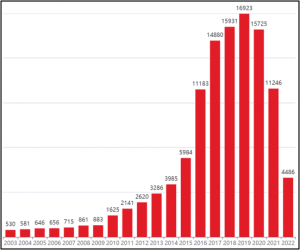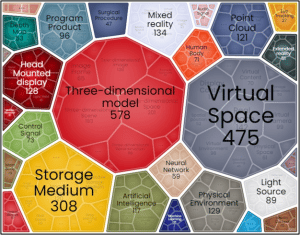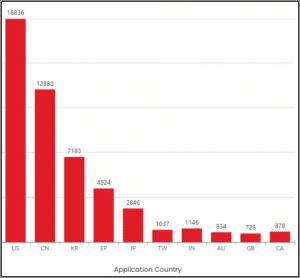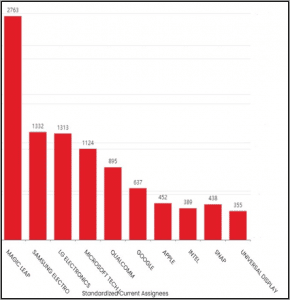XLSCOUT’s Techscaper, with just a few clicks creates a patent landscape report tailored to your needs. Subsequently, it assists you in resolving data discrepancy woes by offering clean and accurate data. Moreover, our data engineering team works diligently to clean and enhance various data points.

What is Technology Landscape Analysis?
Forecasting and comprehending the effects of rapid technological advancements on the value of their products and services is a major challenge for businesses making investment decisions. In general, technology landscape analysis generates reports that are designed to provide a snapshot of ongoing research (existing products, research papers, and patents) in a given technology domain and to assist businesses in determining how to budget and invest in R&D.
For example, Xerox and Polaroid derived significant value from their extensive and innovative patent portfolios. Accordingly, we can learn how they employed patents effectively to safeguard their inventions and gain the highest possible market leverage by looking at their patents.
In this article, we will look at how to understand and analyze a patent portfolio to gain valuable qualitative and quantitative insights. It is an important step in understanding the current market’s threats and opportunities.
A patent landscape report (PLR) is a visual representation of multiple attributes of a given patent portfolio, such as graphs and plots (assignee, geographic distribution, and patent family). Moreover, it reveals insights such as patenting trends, geographic protections, top inventors, research focus, and collaboration partners.
Landscape reports can also show a company’s relative patenting strength as well as which patents it is actively investing in to protect, indicating how important those patents are.
Further, these reports are used to gather actionable competitive intelligence, identify patent white spaces, forecast market trends, and identify trends in investment areas of interest.
Scope and Limitations of a Technology Landscape Report
What specific questions can we expect a patent landscape report to answer?
Scope
To understand the scope of a patent landscape report, let’s take a look at a few screenshots.
We’ll be looking at XLSCOUT’s automated patent landscaping tool – Techscaper’s patent landscape report on Augmented Reality. Let’s get started.
Question 1: How have patent filings for Augmented Reality changed over time? Is patenting activity increasing or decreasing?

The report suggests that the number of patents have been steadily increasing since 2003. As a matter of fact, the filings gained momentum up to 2019 and then dipped slightly. A patent family is a set of patent filings made in various countries to protect a single invention.
Question 2: Which are the technologies that are being used to address the problem of Augmented Reality?

Question 3: Who are the key players? Where are the key players filing their patents?


We can see that the majority of patents in this domain are being filed in US, China, Korea, Europe & Japan. Further, we can also see that the number of patents filed by major players Magic Leap, Samsung Electric, LG Electronics & Microsoft Tech.
These are just some of the questions that a PLR might attempt to answer. Depending on the ultimate goal, the scope can be expanded to answer additional questions such as:
- What is the distribution of patent filing companies? Are they start-ups, industrial conglomerates, or universities?
- What licensing or litigation activity has occurred for the given patent family in the last few years?
- What is the legal status of the following patent families? (Granted/Withdrawn/Rejected)
- How many revisions were made on an average before a patent was accepted?
Limitations
While patent landscape reports provide quantitative analysis, they do not provide qualitative insights into the patents’ subject matter. They would have been unable to answer questions like:
- Are the disclosed patents truly novel and innovative methods for solving a given problem?
- How well are the claims written and scoped?
- Are the patents really valid? Keep in mind that just because a patent has been granted, that does not mean it is valid. A granted patent can be revoked during post-grant opposition and appeal procedure.
Next, let’s consider some of the advantages of conducting a comprehensive patent landscape analysis.
Advantages of Patent Landscape Analysis
- Business development teams can determine the key assignees for a given technology. This is useful for evaluating potential acquisitions, competitors, licensing opportunities, suppliers, or customers, as well as determining whether it is financially feasible to develop the technology in-house.
- Technology landscape analysis data can be utilized to counter competitor strategies, find potential partners to form licensing partnerships for novel technologies, or design around patented technologies to avoid litigation.
- Patent landscape reports can be used by legal teams to identify geographic advantages you might gain by protecting your inventions and filing oppositions to invalidate patents, which may hinder your future expansion plans.
- This is also extremely valuable information for investors to make well-informed decisions by analyzing the proposed technologies and their applications more closely.
Hence, a well-rounded IP strategy not only increases a company’s chances of success, but it can also expose it to significant risk if it fails to comprehend the patent landscape. Let’s take a look at some of these risks.
Risks of failing to understand the patent landscape
- A lack of knowledge about patent protections may result in incorrect product decisions.
- Patents can be an asset if they are well written, and their owner has sufficient funds and resources to enforce them. Because large corporations have more resources to support and defend their patents, they can also employ them as a weapon against smaller competitors.
- Being a technology company with few or no patents may severely limit your bargaining power. In case, if a larger player threatens to enforce their patent, you may lose the opportunity to license your technology or be forced to sell your invention under extreme pressure.
Conclusion
In conclusion, patent landscape analysis is critical for understanding market threats and opportunities. Above all, it is significant market intelligence data that can assist your technology and business teams in planning ahead of time and identifying game-changing opportunities.
Our Methodology
XLSCOUT’s AI-powered patent analytics tools leverage explainable AI-based technologies to help businesses discover relevant technical information quickly. With XLSCOUT, it is ever so easier now to compare and analyze technology trends over time. You can now view and compare the latest trends in a specific technology using graphical dashboards and insightful landscape reports. Moreover, you can also identify the changes in competitor strategies.

